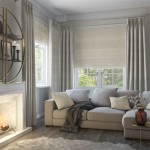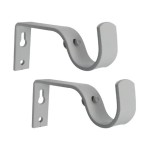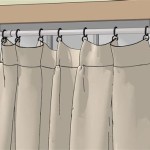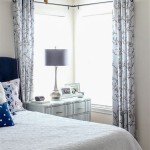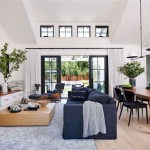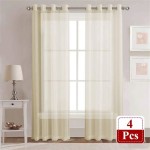Double Layer Curtains for Living Room: Functionality and Aesthetics
Double layer curtains, also known as dual layer curtains or layered curtains, represent a sophisticated window treatment option for living rooms. They involve combining two distinct curtain panels, typically one sheer and one opaque or blackout, to offer a versatile solution for light control, privacy, insulation, and aesthetic appeal. The implementation of double layer curtains allows homeowners to adapt their living room environment to varying needs and preferences throughout the day and across seasons.
The design and installation of double layer curtains necessitate careful consideration of various factors, including the specific functions desired, the existing décor, the dimensions of the window, and the materials used. These choices collectively determine the effectiveness and visual harmony of the window treatment.
Enhanced Light Control and Privacy
A primary benefit of double layer curtains is the enhanced level of light control they provide. The sheer layer diffuses natural light, creating a soft and ambient atmosphere. This is particularly advantageous during daylight hours when complete darkness is not desired, but glare from direct sunlight needs to be reduced. The sheer fabric allows light to penetrate while simultaneously filtering out harsh rays, protecting furniture and flooring from potential fading. Furthermore, the sheer layer offers a degree of privacy during the day, preventing clear visibility into the living room from the outside.
The opaque or blackout layer, on the other hand, provides maximum light blockage when required. This is particularly useful for movie nights, afternoon naps, or for individuals sensitive to light. Blackout curtains effectively eliminate external light sources, creating a darkened environment conducive to sleep or focused activity. When the opaque layer is drawn closed, it also significantly enhances privacy, completely obstructing the view into the living room.
The ability to independently adjust each layer allows for a wide range of light and privacy options. The sheer layer can be used alone during the day, the opaque layer can be drawn at night, or both layers can be combined to achieve a desired level of light filtering and privacy. This flexibility is a significant advantage compared to single-layer curtains, which offer less nuanced control.
The choice of fabrics for each layer is critical in determining the overall light control effectiveness. Sheer fabrics vary in their level of transparency, ranging from very fine and almost imperceptible to slightly heavier weaves that offer more privacy. Opaque fabrics also vary in their light-blocking capabilities. Blackout curtains are typically made of dense, tightly woven materials with a special coating to prevent light penetration. The selection should align with the specific needs of the living room and the desired level of light and privacy control.
Improved Insulation and Energy Efficiency
Double layer curtains contribute to improved insulation and energy efficiency in the living room. The two layers of fabric create an additional barrier between the interior space and the exterior environment. This barrier helps to reduce heat transfer during both summer and winter months, leading to lower energy consumption and reduced utility bills.
In the summer, the curtains help to block out solar heat, preventing the living room from overheating. By reducing the amount of heat entering the space, the air conditioning system does not have to work as hard to maintain a comfortable temperature. This can result in significant energy savings over time.
During the winter, the double layer of fabric helps to retain heat inside the living room. The curtains act as a buffer, preventing warm air from escaping through the windows. This reduces the workload on the heating system and helps to maintain a more consistent temperature within the space.
The effectiveness of double layer curtains in improving insulation depends on several factors, including the type of fabric used, the tightness of the weave, and the fit of the curtains to the window. Fabrics with a denser weave and a tighter fit will provide better insulation than lighter, more loosely woven fabrics. Thermal curtains, specifically designed for insulation, are often used as the opaque layer in double layer curtain setups to maximize energy efficiency. These curtains typically have a special lining that reflects heat back into the room or blocks heat from entering.
The installation method also plays a role in insulation effectiveness. Curtains that are hung close to the window and extend beyond the window frame will provide better insulation than curtains that are hung further away or are narrower than the window. Sealing any gaps around the edges of the curtains with tape or weather stripping can further enhance insulation performance.
Enhanced Aesthetic Appeal and Design Versatility
Beyond their functional benefits, double layer curtains offer significant aesthetic advantages and design versatility. The combination of two different fabrics provides an opportunity to create a layered and visually appealing window treatment that complements the overall décor of the living room. The layering effect adds depth and texture to the window, making it a focal point of the room.
The choice of colors, patterns, and textures for each layer allows for a wide range of design possibilities. The sheer layer can be used to introduce a subtle hint of color or pattern, while the opaque layer can provide a bolder statement. Alternatively, the two layers can be chosen to complement each other in a harmonious way, creating a cohesive and balanced look. The ability to mix and match different fabrics allows homeowners to personalize their window treatments to reflect their individual style and preferences.
The sheer layer can also be used to soften the appearance of the opaque layer, especially if the latter is made of a heavier or more formal fabric. The sheer fabric adds a touch of lightness and airiness, preventing the opaque layer from feeling too heavy or overwhelming. This is particularly useful in smaller living rooms where a lighter and more open feel is desired.
Hardware choices, such as curtain rods and rings, also contribute to the overall aesthetic appeal of double layer curtains. The curtain rod should be sturdy enough to support the weight of both layers of fabric. Decorative curtain rods can add a touch of elegance and sophistication to the window treatment. The choice of rings or clips can also affect the way the curtains hang and drape, influencing the overall look and feel.
Moreover, the layering technique can be used to create different visual effects. For example, using a patterned sheer fabric over a solid-colored opaque fabric can create a subtle and intriguing pattern overlay. Alternatively, using two different solid colors can create a color-blocking effect that adds visual interest to the room.
Furthermore, the ability to change out the shear layer with different patterns or colors enables easy seasonal updates to the room without the need to replace the more expensive blackout curtains. This added versality saves money, while adding different aesthetics year round.
In summary, double layer curtains offer a compelling combination of functionality and aesthetics for living rooms. Their ability to control light, enhance privacy, improve insulation, and add visual appeal makes them a versatile and valuable window treatment option. Careful consideration of the specific needs and preferences of the homeowner, along with thoughtful selection of fabrics and hardware, is essential to achieving the desired results.
The initial cost of double layer curtains can be higher than that of single-layer curtains, due to the need for two sets of fabric and a potentially more robust curtain rod. However, the long-term benefits of improved energy efficiency, enhanced light control, and increased aesthetic value often outweigh the initial investment. In addition, the durability of quality curtain fabrics ensures that the investment will last for many years.
Proper maintenance is essential to prolong the life and maintain the appearance of double layer curtains. Regular dusting or vacuuming can help to remove dirt and debris from the fabric. Depending on the fabric type, occasional washing or dry cleaning may be necessary. Following the manufacturer's instructions for cleaning and care will help to prevent damage and ensure that the curtains continue to look their best for years to come.
Ultimately, the decision of whether or not to use double layer curtains in a living room depends on individual needs and preferences. However, for those seeking a versatile and aesthetically pleasing window treatment option that offers enhanced light control, privacy, and insulation, double layer curtains represent a valuable and potentially transformative choice.
Ready Stock Luxury Flowers Double Layer Blackout Curtains For Sliding Doors Green Elegant Embroidery Voile Drapes Thermal Insulated Living Room
Luxury Embroidery Double Layer Curtains For Living Room Bedroom European Blackout With Valances Window Villa Decora

1 Pc Blackout Gradient Curtains For Living Room Tulle Drape Valance Double Layer

1 Pc Blackout Princess Curtain Double Layer For Living Room Floral Tulle Drape
Double Layer Lace High End Full Blackout Curtains Ins Nordic Princess Style Finished For Living Room And Bedroom Balcony

Factory Direct 4d Embroidered Double Layer Curtains For The Living Room Embroidery Curtain And Polyester Blinds Made In China Com

Layered Curtains Ideas Tips For Layering The Shade

1pc Double Layer Curtain

Amidoudou 1 Pair Luxury 3d Flower Embroidered Curtains For Bedroom European Double Layer With Valances Living Room Beige 52x84 Inch

Linen Blackout Curtains For Living Room Double Layer Vintage Lace Pinch Pleat Velvet Bedroom Efairgo

